Cheat Summit Fort 1861-1862
Introduction
Text-to-speech Audio
General George B. McClellan ordered this fort to be built in 1861 to secure the Staunton-Parkersburg Turnpike and protect the Baltimore and Ohio Railroad. The fort, local Union supporters, and the Union soldiers stationed here helped to keep this part of western Virginia, later the state of West Virginia, under Union control. Also known at Fort Milroy, it is the highest known Union fortification in the east. The battle of Cheat Mountain was the first battle of the Civil War in which Robert E. Lee led troops into combat. During the battle, Lee attempted to surround the Union garrison atop Cheat Mountain, but the attack was never launched, due to false information from prisoners and poor communications among the various Confederate commands. Today very little remains of the fort, however, there are markers and diagrams to show the location of the fort and temporary graves of Union casualties. There are regular living histories and reenactments at Cheat Summit Fort every April or early May.
Images
Historical marker at the site
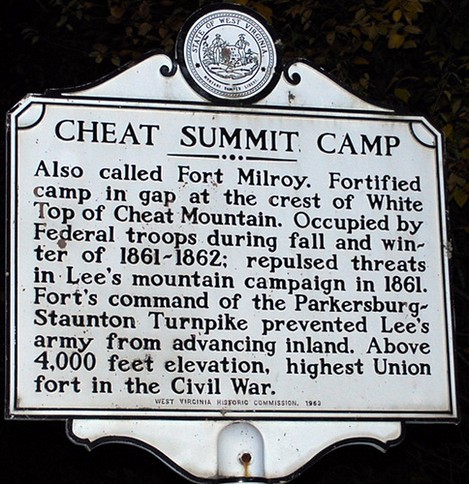
Learn more about the war in West Virginia with Michael Graham's book, The Coal River Valley in the Civil War: West Virginia Mountains, 1861.
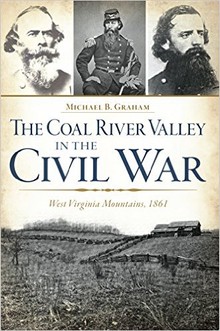
Cheat Summit Fort Marker
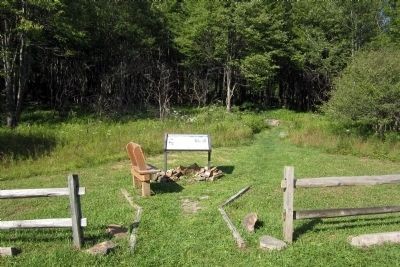
Skirmishes and Movements Adjacent to Cheat Summit Fort.
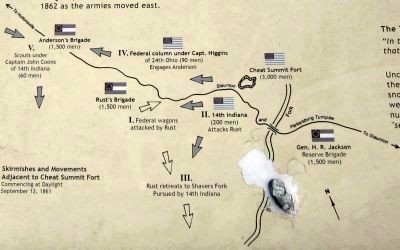
Cheat Mountain
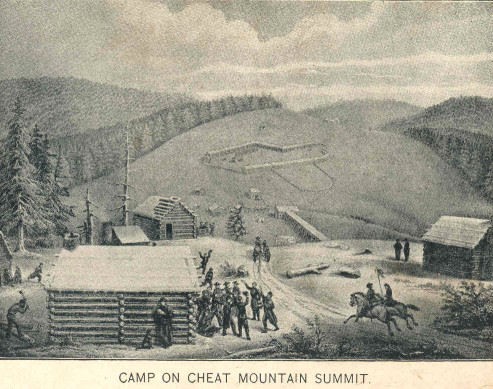
Backstory and Context
Text-to-speech Audio
On September 11, in a steady, drenching rain, part of the Confederate force made contact with Reynolds's outpost. The next morning, as the rain continued to pour down, Lee pressed his attack, but his plan was too complicated for his inexperienced troops. The surprise attack on the summit never came, and Lee's plan quickly fell apart. Captured Union soldiers convinced Lee that he was outnumbered two to one when he actually commanded six men for every one Union soldier. Meanwhile, Reynolds received reinforcements and skirmishing continued on September 13. Lee, having lost the element of surprise and knowing the federal troops held an impregnable position, withdrew his troops. Casualties in the battle were light-100 Confederate and 21 Union soldiers. Lee's failure was severely criticized. Dubbed "Granny Lee", he was shipped off to South Carolina to supervise fortifications.
Unfortunately, battle was not the only cause of death in the Civil War. Harsh weather conditions and elements were hard to survive, and made disease run rampant. One soldier encamped at Cheat Summit Fort, Elijah Cavins, reported saying that, “in the usually mild September, horses chilled to death in that camp.” The first snowfall reported at Cheat Summit Fort was in mid August, so you can only imagine what the soldiers had to endure as winter progressed. The soldiers who survived claimed that their time at the camp having to remain throughout the rough weather patterns was the hardest part of staying alive.1
"In September of 1861 of General Robert E. Lee directed the Confederate Army of the Northwest to isolate and attack Cheat Summit Fort and Camp Elkwater (approximately 8 miles west). On September 12, a Confederate brigade under Colonel Albert Rust engaged Federal skirmishers in the dense woods west of the fort. Unaware they outnumbered the foe, Rust’s forces retreated, falling to signal a wider attack. Additional Confederate setbacks near Camp Elkwater on September 13-14 ended Lee’s offensive."1The Confederacy’s inability to take the fort in September, 1861, was central in the failure of Robert E. Lee’s western Virginia Campaign. In the October battle of Greenbrier River, troops from Cheat Summit Fort, under General R. H. Milroy, attacked Camp Bartow. Neither side could claim victory and the Union troops returned to Cheat Summit Fort while the Confederates withdrew to Camp Allegheny. The location of Cheat Summit Fort was very strategic. The high altitude allowed Union troops to have a birds eye view of the area and valleys surrounding them. It was difficult, and nearly impossible for there to be a surprise attack on the camp. This location also allowed for the control and protection of the Staunton-Parkersburg Turnpike and the Baltimore & Ohio Railroad. The location of the camp was a huge factor in the reasoning behind the confederacy's failed attempt to seize Cheat Summit Fort.
Unfortunately, battle was not the only cause of death in the Civil War. Harsh weather conditions and elements were hard to survive, and made disease run rampant. One soldier encamped at Cheat Summit Fort, Elijah Cavins, reported saying that, “in the usually mild September, horses chilled to death in that camp.” The first snowfall reported at Cheat Summit Fort was in mid August, so you can only imagine what the soldiers had to endure as winter progressed. The soldiers who survived claimed that their time at the camp having to remain throughout the rough weather patterns was the hardest part of staying alive.1
Sources
1. “Cheat Summit Fort Historical Marker.” 2006. Accessed August 31, 2016. http://www.hmdb.org/marker.asp?marker=58239.
2. Civil War Trust. “Cheat Summit Fort.” 2014. Accessed August 31, 2016. http://www.civilwar.org/civil-war-discovery-trail/sites/cheat-summit-fort.html?referrer=https://www.google.com/.
